When and how to transplant an orchid at home: terms and rules
Orchids confidently entered our life. These epiphytes attract not only with beautiful flowers, but also with their dissimilarity to the usual indoor plants. Therefore, caring for them is also different.
Content:
- Orchids: species, varieties
- When to replant an orchid
- Preparing for transplant
- Transplanting an orchid
Orchids: species, varieties
The most popular types of indoor orchids:
- Phalaenopsis very beautiful, their flower looks like a bright butterfly. Has a large number of colors and shades. Abundant flowering is observed in autumn and winter. The buds are laid when the night temperature drops. Caring for Phalaenopsis is quite simple, it blooms almost all year round. The rest period is short. Can grow on any window. Phalaenopsis does not like drafts. During flowering and budding, the plant is not transferred to another place. Watered once a week, protected from direct sunlight on the southern windows. They are fed with complex fertilizer for orchids. The optimum temperature for growing is about 20 ° C. Can withstand temperatures as low as 15 ° C. The main phalaenopsis varieties are Schindler, Stuart, and Pleasant.
- Wanda is an orchid that grows with bare roots. Absorbs moisture from fog and rain. It does not need any substrate or support. Primary colors are yellow, blue, red. The plant thrives on the southern and southeastern windows. Requires shading at noon. In the summer they watered every other day, in the winter once a week. In the summer, he feels good on the balcony, but you need to gradually get used to the bright sunny color. It is better to grow in pieces of pine bark from 2 cm in size. Growing in a gel filler is harmful to the plant. It blooms for about 3 months a year. Each flower does not fade for a long time. Foliar feeding is carried out. When watering, add fertilizer for orchids almost every time.
- Cattleya blooms with spectacular large flowers. Color - white, red, purple. The plant is quite capricious to care for. Requires a lot of light. If it is not enough, Cattleya may not bloom. Grown on the south and southeast windows. In the north, it needs to be supplemented. At the end of summer, covers begin to form, in which the buds ripen. At this time, the orchid needs to be fed with potassium-phosphorus fertilizers. After flowering, the orchid begins a dormant period. At this time, she is not fed.
- Cymbidium is commonly used for bouquets. They reach a height of 1 m. Under indoor conditions they do not bloom, but they can grow. In the spring he is taken outside, where he is kept until the temperature drops to 5 ° C. It is positioned so that during the day it is in the shade, and in the evening scattered rays of light fall on it.
- Paphiopedilum (Lady's Slipper) can be grown on any window. The humidity in the room for growing the Shoe should be 50%, the temperature should be from 18 to 25 ° C. It reacts to high temperatures in summer with degeneration. Watered by soaking or from a watering can. Make sure that no water gets into the center of the outlet. The substrate is not overdried or overfilled.
When to replant an orchid
Usually, potted flowers are transplanted after the roots have braided the entire pot and begin to peek out from the drainage hole. But for orchids, these indicators cannot serve as a reason for replanting.After all, their roots in a normal state can stick out from the top and bottom of the pot.
Sometimes a newly purchased plant is transplanted. But if the orchid looks good, blooms, its roots are clean, without dark or dry spots, it is quite possible not to transplant it. If the substrate is not enough, add pine bark, moss, previously steamed and dried. If the roots are shriveled and depleted after treatment with flowering stimulants, it is also better to transplant the orchid.
The better the care of the orchid, the faster it grows, increasing root system, the faster it needs to be transplanted.
If the orchid is doing well, it is best not to disturb it or move it out of the pot for up to three years. After all, each such operation is a strong stress for the flower. But sometimes it is simply necessary to transplant it:
- If the roots have completely displaced the substrate from the pot.
- The substrate has become fine-grained, the bark has stratified, sphagnum moss does not absorb moisture.
- Orchid roots have rotted or dried out.
- They started up in the pot pests.
In the first two cases, you can not rush to transplant, wait until early spring or autumn. Cases of root rot and the appearance of pests are critical. They require an immediate transplant. But first, you need to do some preparatory work. Prepare a new substrate and pot. In flowering orchids, with an urgent transplant, the peduncles are cut by 2 cm with a sharp knife. After this procedure, the roots increase, lateral peduncles are formed.
Preparing for transplant
They buy or prepare dishes. Ceramic pots can be used to grow orchids. But it is better to use glass, even better - plastic. Their surface is smooth, so the roots will not grow into the unevenness of the pot, and during the next transplant they are injured when trying to detach them. A transparent pot, unlike a ceramic one, lets in sunlight, which is involved in photosynthesis. You cannot cut a glass pot, so you will have to constantly drain the excess water.
When choosing utensils for transplanting, take into account the type of orchid.
For example, if these are epiphytes, then they take a pot with holes not only in the bottom, but also in the walls. You can make the holes yourself. The size of the new pot is taken with a diameter of 3-5 cm larger than the previous one. You don't need to buy too much, because the orchid will bloom much less in it. But the leaves will grow more actively.
It is very important to prepare a quality substrate. The soil for an orchid consists of large pieces of pine bark, sphagnum moss, expanded clay, foam. Charcoal protects roots orchids from decay. Why should the constituents of the substrate be large? The roots of the orchid will cling to them.
The substrate should contain fairly dense and strong fragments. After all, the roots over time squeeze these components, crushing them. Therefore, soil with strong pieces will stay soft longer, and you can transplant the orchid later. Pieces of pine bark increase the breathability of the substrate. Their destruction leads to compaction of the soil, and this, in turn, to rotting of the roots. After all, they can no longer quickly ventilate and dry out. The acidity of the substrate is pH 5.5-6.5.
In addition, you need to prepare a tool: scissors or a sharp pruner. They are disinfected before use.
Several tablets of activated charcoal or pieces of charcoal for processing sections. Prepare water at room temperature, having previously defended it. It is advisable to prepare insecticide and fungicide even if there are no visible traces of damage by pests or diseases. Indeed, during transplantation, it may turn out that they are needed. Do not run to the store with a pulled out flower in your hands.
Transplanting an orchid
Where to start and what to do:
- Before planting an orchid in a new pot, it must be removed from the old one. It's not always easy. After all, the roots firmly cling to the smallest protrusions in the pot.To make this easier, you must first soak the pot in warm, soft water. The substrate lags behind the pot and roots, and they themselves gain moisture and become less brittle.
- After the pot has stood in the water for a few minutes, take it out. Lightly knead the plastic pot with your hands to free the walls from contact with the roots. Roots stuck in the drainage holes are a particular problem. They cannot be cut off so that they do not rot. It's easier to donate a pot. Carefully cut it open to release the roots.
- After removing the orchid from the pot, wash off the remaining substrate under running water at room temperature. Pests are washed off along with pieces of old bark. If pests or traces of the disease are noticed on the roots. They are treated with prepared insecticides or fungicides. Spider mites are killed with acaricides.
- Examine roots and leaves carefully orchids... Remove yellowed, dried, wilted. All sections are treated with crushed coal and dried.
- A small amount of the prepared mixture is placed on the bottom of the dish. An orchid is installed in it. The roots are smoothed whenever possible. The areas between them and the walls of the pot are filled with a mixture. Do not seal it. Do not push all air roots into the pot. It is necessary to ensure that the plant is kept in the pot. Soon the roots will take hold more securely.
After transplanting, the orchid is installed so that direct sunlight does not fall on the leaves. The humidity in the room is increased by 50%, the temperature is maintained at about 20 ° C. At first, the flower is not watered. Watering is resumed only after 5 days. And the first feeding is carried out in a month.
More information can be found in the video:



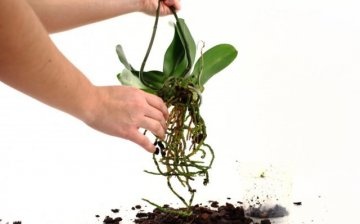
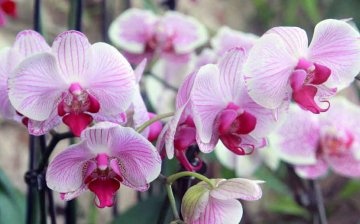
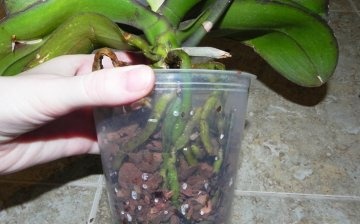
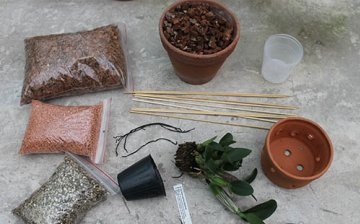






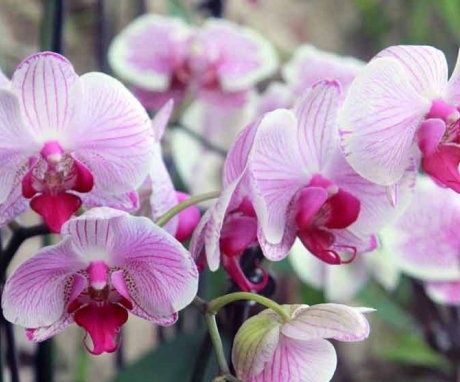

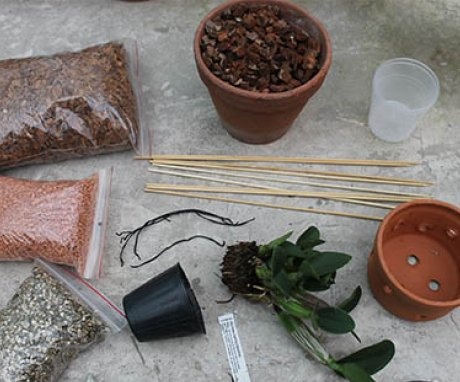
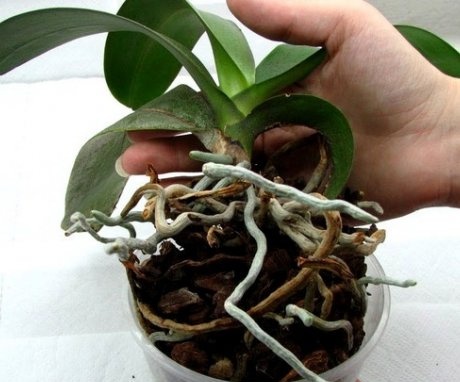
We have Phalaenopsis orchid for more than five years and have transplanted it only once. Our flower is in a plastic pot, with a nutritious substrate, holes are drilled in its walls.
I transplant my phalaenopsis when their roots are completely falling out of the pot and do not fit there, threatening to fall along with the pot. They grow in plastic pots, but stand in pots so that excess moisture can drain off and look beautiful.